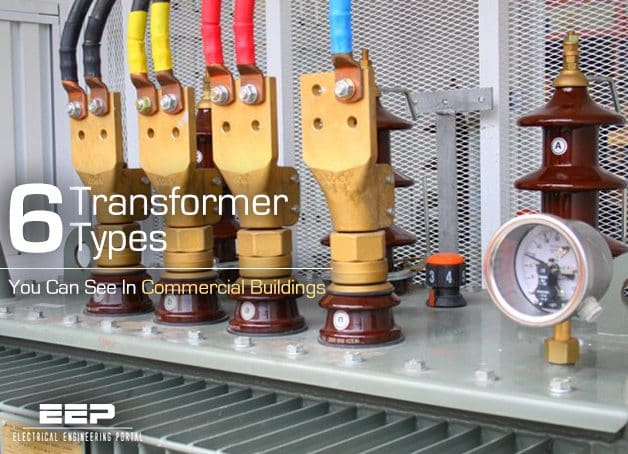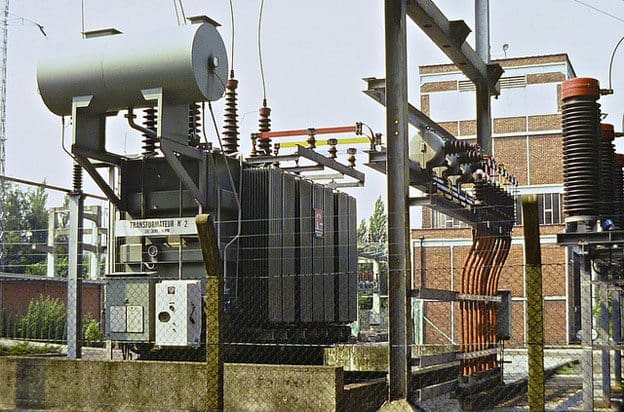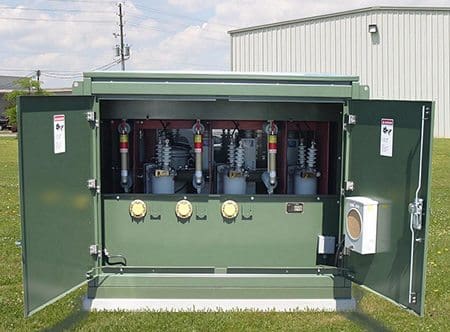
6 Transformer Types You Can See In Commercial Buildings (photo credit: iml.bg)
Transformer Types and their Characteristics
Transformers in commercial installations are normally used to change a voltage level from a utility distribution voltage to a voltage that is usable within the building, and are also used to reduce building distribution voltage to a level that can be utilized by specific equipment. Applicable standards are the ANSI C57 Series and NEMA TR and ST Series.
The following six types of transformers are normally used in commercial buildings:
- Substation
- Primary-unit substation
- Secondary-unit substation (power center)
- Network
- Pad-mounted
- Indoor distribution
Many other types of transformers are manufactured for special applications, such as welding, constant voltage supply, and high-impedance requirements. Discussion of the special transformers and their uses is beyond the scope of this recommended practice.
1. Substation Transformers
Used with outdoor substations, they are rated 750-5000 kVA for single-phase units and 750-25 000 kVA for three-phase units.

High voltage transformer 40MVA (Steps down 150kv to 10kV in a substation in Belgium. Photo taken 1983.)
The primary voltage range is 2400 V and up. Taps are usually manually operated while de-energized; but automatic load tap changing may be obtained. The secondary voltage range is 480-13 800 V. Primaries are usually delta connected, and secondaries are usually wye connected because of the ease of grounding the secondary neutral.
The insulation and cooling medium is usually liquid. High-voltage connections are on cover-mounted bushings. Low-voltage connections may be cover-mounted bushings or an air terminal chamber.
2. Primary-Unit Substation Transformers
Used with their secondaries connected to medium-voltage switchgear, they are rated 1000-10 000 kVA and are three-phase units. The primary voltage range is 6900-138 000 V. The secondary voltage range is 2400-34 500 V.

Primary-Unit Substation Transformer (photo credit: actom.co.za)
Taps are usually manually changed while de- energized; but automatic load tap changing may be obtained. Primaries are usually delta connected. The type may be oil, less-flammable liquid, air, dry, cast-coil, or gas. The high-voltage connections may be cover bushings, an air terminal chamber, or throat. The low-voltage connection is a throat.
3. Secondary-Unit Substation Transformers
Used with their secondaries connected to low-voltage switchgear or switchboards, they are rated 112.5-2500 kVA and are three-phase units. The primary voltage range is 2400-34 500 V. The taps are manually changed while de-energized. The secondary voltage range is 120-480 V.

Trihal – Dry-type transformer 1600 kVA 10/0,42kV connected to busbar system Canalis KTA 2500A (Schneider Electric)
The primaries are usually delta-connected, and secondaries are usually wye connected. The type may be oil, less-flammable liquid, air, dry, cast-coil, or gas. The high-voltage connections may be cover bushings, an air terminal chamber, or throat. The low-voltage connection is a throat but it may also be by bus duct.
4. Network Transformers
Used with secondary-network systems, they are rated 300-2500 kVA. The primary voltage range is 4160-34 500 V. The taps are manually operated while de-energized. The secondary voltages are 208Y/120 V and 480Y/277 V.

Network transformer – Subway type (photo credit: pioneertransformers.com)
The type may be oil, less-flammable liquid, air, dry, cast-coil, or gas. The primary is delta connected, and the secondary is wye-connected. The high-voltage connection is generally a network switch (on-off-ground) or an interrupter-type switch with or without a ground position. The secondary connection is generally an appropriate network protector, or a low-voltage power air circuit breaker designed to provide the functional equivalent of a network protector.
A subway-type unit is suitable for frequent or continuous operation while submerged in water; a vault-type unit is suitable for occasional submerged operation.
5. Pad-Mounted Transformers
Used outside buildings where conventional unit substations might not be appropriate, and are either single-phase or three-phase units. Because they are of tamper-resistant construction, they do not require fencing.

Pad-mount outdoor transformer
Primary and secondary connections are made in compartments that are adjacent to each other but separated by barriers from the transformer and each other. Access is through padlocked hinged doors designed so that unauthorized personnel cannot enter either compartment.
Where ventilating openings are provided, tamper-resistant grills are used. Gauges and accessories are in the low- voltage compartment.
- These units are rated 75-2500 kVA.
- The primary voltage range is 2400-34 500 V.
- Taps are manually changed while de-energized.
- The secondary voltage range is 120-480 V.
Primaries are almost always delta connected or special construction wye connected, and secondaries are usually wye connected. A delta-connected tertiary is not acceptable with a three-legged core unless an upstream device opens all three phases for a single-phase fault.
The type may be oil, less-flammable liquid, air, dry, cast-coil, or gas. The high-voltage connection is in an air terminal chamber that may contain just pressure- or disconnecting-type connectors or may have a disconnecting device, either fused or unfused. The connections may be for either single or loop feed. The low-voltage connection is usually by cable at the bottom; but it may also be by bus duct.
Cant see this video? Click here to watch it on Youtube.
The dry-type, pad-mounted transformer does not have the inherent fire hazards of the oil filled, pad-mounted transformer and frequently the dry-type, pad-mounted transformer is mounted on the roofs of buildings so that it will be as near to the load center as possible.
ANSI C57.12.22-1989 [5] applies to oil immersed units with primary voltages of 16 340 V and below.
6. Indoor Distribution Transformers
Used with panelboards and separately mounted, they are rated 1-333 kVA for single-phase units and 3-500 kVA for three-phase units. Both primaries and secondaries are 600 V and below (the most common ratio is 480-208Y/120V).

Indoor substation transformer
The cooling medium is air (ventilated or nonventilated). Smaller units have been furnished in encapsulated form. High- and low-voltage connections are pressure-type connections for cables. Impedances of distribution transformers are usually lower than those of substation or secondary-unit substation transformers.
The majority of transformers for distributing power at 480 V in a commercial building are usually referred to as “general-purpose transformers” and secondaries are typically rated at 208Y/120 V. These transformers are mostly of the dry-type, and some of the smaller sized ones are encapsulated. General-purpose transformers are used for serving 120 V lighting, appliances, and receptacles.
Other Transformer Types //
Virtually all power transformers used in commercial buildings are of the two-winding type, which may be referred to as isolating or insulating transformers, and are distinct from the one-winding type known as the autotransformer. The two-winding-type transformer provides a positive isolation between the primary and secondary circuits; which is desirable for safety, circuit isolation, reduction of fault levels, coordination, and reduction of electrical interference.
Specialty transformers used in applications where the least amount of leakage current could cause an arc and ignite the atmosphere (such as in an oxygenated environment) or cause personal injury (such as in open heart surgery) will require an ungrounded secondary.

Figure 2 – Direct-Current Electric Arc Furnace (DC EAF) Transformer
In the most sensitive applications, the leakage current may be monitored and is controlled by introducing a grounded shield between the primary and secondary coils. Such a shield also reduces electromagnetic interference (EMI), which may be present in the primary.
Reference // IEEE Recommended Practice for Electric Power Systems in Commercial Buildings